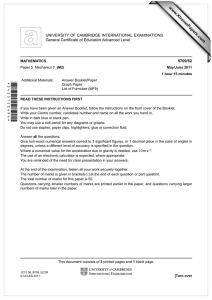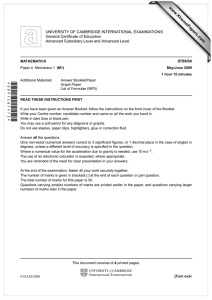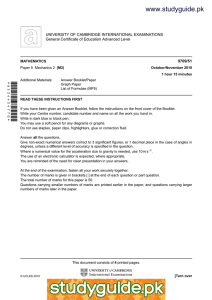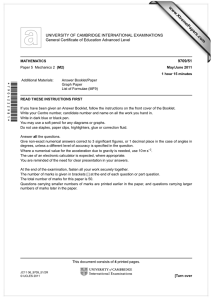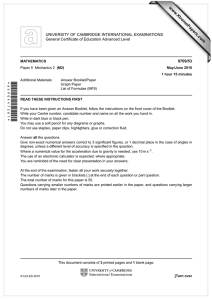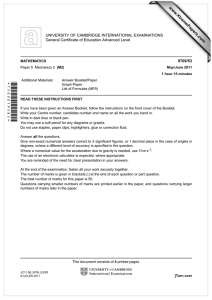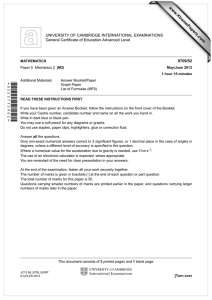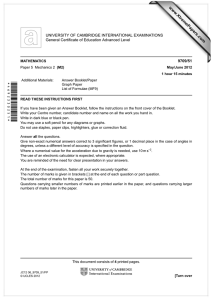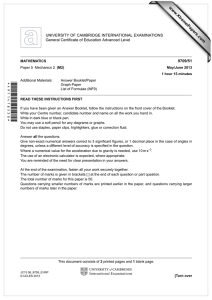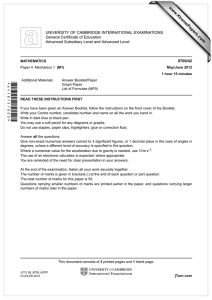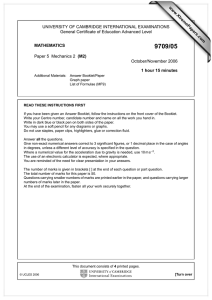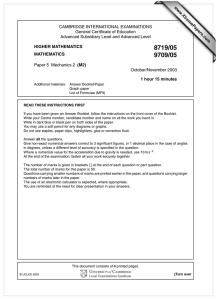* 4 3 9
advertisement
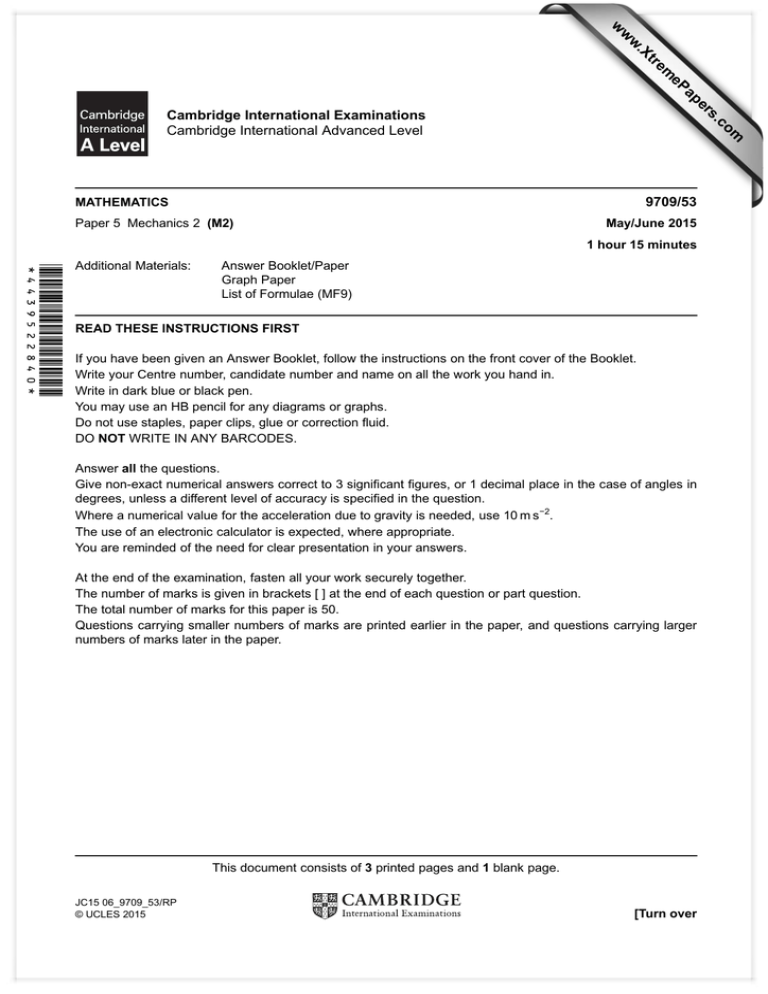
w w ap eP m e tr .X w s er om .c Cambridge International Examinations Cambridge International Advanced Level 9709/53 MATHEMATICS Paper 5 Mechanics 2 (M2) May/June 2015 1 hour 15 minutes *4439522840* Additional Materials: Answer Booklet/Paper Graph Paper List of Formulae (MF9) READ THESE INSTRUCTIONS FIRST If you have been given an Answer Booklet, follow the instructions on the front cover of the Booklet. Write your Centre number, candidate number and name on all the work you hand in. Write in dark blue or black pen. You may use an HB pencil for any diagrams or graphs. Do not use staples, paper clips, glue or correction fluid. DO NOT WRITE IN ANY BARCODES. Answer all the questions. Give non-exact numerical answers correct to 3 significant figures, or 1 decimal place in the case of angles in degrees, unless a different level of accuracy is specified in the question. Where a numerical value for the acceleration due to gravity is needed, use 10 m s−2. The use of an electronic calculator is expected, where appropriate. You are reminded of the need for clear presentation in your answers. At the end of the examination, fasten all your work securely together. The number of marks is given in brackets [ ] at the end of each question or part question. The total number of marks for this paper is 50. Questions carrying smaller numbers of marks are printed earlier in the paper, and questions carrying larger numbers of marks later in the paper. This document consists of 3 printed pages and 1 blank page. JC15 06_9709_53/RP © UCLES 2015 [Turn over 2 1 A uniform semicircular lamina has diameter AB of length 0.8 m. (i) Find the distance of the centre of mass of the lamina from AB. [2] The lamina rests in a vertical plane, with the point B of the lamina in contact with a rough horizontal surface and with A vertically above B. Equilibrium is maintained by a force of magnitude 6 N in the plane of the lamina, applied to the lamina at A and acting at an angle of 20Å below the horizontal. (ii) Calculate the mass of the lamina. 2 [3] A particle P is projected with speed V m s−1 at an angle of 60Å above the horizontal from a point O on horizontal ground. P is moving at an angle of 45Å above the horizontal at the instant 1.5 s after projection. (i) Find V . [3] (ii) Hence calculate the horizontal and vertical displacements of P from O at the instant 1.5 s after projection. [2] 3 One end of a light elastic string of natural length 0.4 m and modulus of elasticity 20 N is attached to a fixed point A on a smooth plane inclined at 30Å to the horizontal. The other end of the string is attached to a particle P of mass 0.5 kg which rests in equilibrium on the plane. (i) Calculate the extension of the string. [2] P is projected down the plane from the equilibrium position with speed 5 m s−1 . The extension of the string is e m when the speed of the particle is 2 m s−1 for the first time. (ii) Find e. 4 [4] A small ball B is projected from a point 1.5 m above horizontal ground with initial speed 29 m s−1 at an angle of 30Å above the horizontal. (i) Show that B strikes the ground 3 s after projection. [2] (ii) Find the speed and direction of motion of B immediately before it strikes the ground. [4] © UCLES 2015 9709/53/M/J/15 3 5 B 0.4 m 0.5 m A 0.25 m D C 0.3 m A uniform triangular prism of weight 20 N rests on a horizontal table. ABC is the cross-section through the centre of mass of the prism, where BC = 0.5 m, AB = 0.4 m, AC = 0.3 m and angle BAC = 90Å. The vertical plane ABC is perpendicular to the edge of the table. The point D on AC is at the edge of the table, and AD = 0.25 m. One end of a light elastic string of natural length 0.6 m and modulus of elasticity 48 N is attached to C and a particle of mass 2.5 kg is attached to the other end of the string. The particle is released from rest at C and falls vertically (see diagram). 6 (i) Show that the tension in the string is 60 N at the instant when the prism topples. [3] (ii) Calculate the speed of the particle at the instant when the prism topples. [5] A cyclist and her bicycle have a total mass of 60 kg. The cyclist rides in a horizontal straight line, and exerts a constant force in the direction of motion of 150 N. The motion is opposed by a resistance of magnitude 12v N, where v m s−1 is the cyclist’s speed at time t s after passing through a fixed point A. (i) Show that 5 dv = 12.5 − v. dt [2] (ii) Given that the cyclist passes through A with speed 11.5 m s−1 , solve this differential equation to show that v = 12.5 − e−0.2t . [4] (iii) Express the displacement of the cyclist from A in terms of t. 7 [3] A particle P of mass 0.7 kg is attached to one end of a light inextensible string of length 0.5 m. The other end of the string is attached to a fixed point A which is h m above a smooth horizontal surface. P moves in contact with the surface with uniform circular motion about the point on the surface which is vertically below A. (i) Given that h = 0.14, find an inequality for the angular speed of P. [4] (ii) Given instead that the magnitude of the force exerted by the surface on P is 1.4 N and that the speed of P is 2.5 m s−1 , calculate the tension in the string and the value of h. [7] © UCLES 2015 9709/53/M/J/15 4 BLANK PAGE Permission to reproduce items where third-party owned material protected by copyright is included has been sought and cleared where possible. Every reasonable effort has been made by the publisher (UCLES) to trace copyright holders, but if any items requiring clearance have unwittingly been included, the publisher will be pleased to make amends at the earliest possible opportunity. To avoid the issue of disclosure of answer-related information to candidates, all copyright acknowledgements are reproduced online in the Cambridge International Examinations Copyright Acknowledgements Booklet. This is produced for each series of examinations and is freely available to download at www.cie.org.uk after the live examination series. Cambridge International Examinations is part of the Cambridge Assessment Group. Cambridge Assessment is the brand name of University of Cambridge Local Examinations Syndicate (UCLES), which is itself a department of the University of Cambridge. © UCLES 2015 9709/53/M/J/15
